Bicycle Travel Bags are essential for transporting your bike safely, especially when exploring scenic destinations like Vietnam with SIXT.VN. Let’s explore top choices and how SIXT.VN can enhance your Vietnam cycling tour.
1. What Are Bicycle Travel Bags and Why Are They Important for Vietnam Tours?
Bicycle travel bags are specialized bags designed to protect your bicycle during transportation, whether by plane, train, or car. They are essential for anyone planning a cycling tour in Vietnam because they safeguard your bike from damage, ensuring it arrives in perfect condition for your adventures. According to a report by the Vietnam National Administration of Tourism, ensuring safe transport of sporting equipment, including bicycles, is crucial for attracting sports tourism, a growing segment in Vietnam.
1.1. Understanding the Definition of Bicycle Travel Bags
Bicycle travel bags are robust containers made from durable materials like nylon, polyester, or hard-shell plastics. They come in various sizes and designs to accommodate different types of bikes, including road bikes, mountain bikes, and folding bikes. These bags often feature padding, internal straps, and separate compartments to secure the frame, wheels, and components.
1.2. Why You Need a Bicycle Travel Bag for Vietnam Cycling Tours
Traveling with your bike in Vietnam requires careful planning, and a high-quality travel bag is non-negotiable. Here’s why:
- Protection: Protects your bike from scratches, dents, and other damage during transit.
- Convenience: Makes it easier to handle and transport your bike through airports, train stations, and other transport hubs.
- Airline Compliance: Meets airline requirements for transporting bicycles as checked baggage.
- Peace of Mind: Reduces stress and worry about the safety of your bike, allowing you to focus on enjoying your trip.
SIXT.VN understands the importance of safe bicycle transport. We offer services that include secure handling and transportation of your bicycle, ensuring it arrives ready for your cycling adventures in Vietnam.
1.3. Common Challenges of Traveling with a Bicycle and How Bicycle Travel Bags Solve Them
Traveling with a bicycle presents several challenges, but the right travel bag can mitigate these issues effectively.
| Challenge | Solution with Bicycle Travel Bags |
|---|---|
| Damage during transit | Padded bags and hard cases protect against impacts and mishandling. |
| Difficulty in handling | Bags with wheels and handles make it easier to maneuver through airports and stations. |
| Airline restrictions | Compliant bags meet size and weight limits, avoiding extra fees or refusal. |
| Organization of components | Separate compartments keep wheels, pedals, and tools organized and prevent them from damaging the frame. |
| Space constraints | Some bags are designed to be compact and foldable for easy storage when not in use. |
By addressing these challenges, bicycle travel bags ensure a smoother, more enjoyable travel experience, especially when exploring Vietnam’s diverse landscapes with SIXT.VN.
2. What Are The Different Types of Bicycle Travel Bags?
Choosing the right bicycle travel bag is crucial for ensuring your bike’s safety and your convenience while traveling. There are primarily two types: soft bags and hard cases, each offering distinct advantages and disadvantages.
2.1. Exploring the Pros and Cons of Soft Bicycle Bags
Soft bicycle bags are typically made from padded fabric materials like nylon or polyester. They are lightweight and often more affordable than hard cases, making them a popular choice for many cyclists.
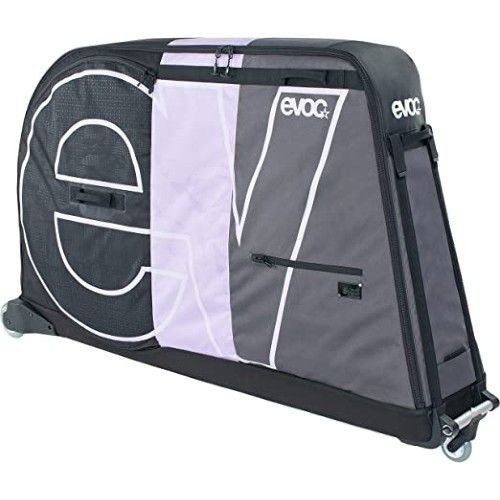 Cyclist packing a bike into a soft bicycle travel bag
Cyclist packing a bike into a soft bicycle travel bag
Alt text: Cyclist carefully places a bicycle into a padded Evoc travel bag for easy transport.
Pros of Soft Bicycle Bags:
- Lightweight: Easier to carry and maneuver, which is crucial when navigating airports and train stations.
- Affordable: Generally less expensive than hard cases, making them a budget-friendly option.
- Easy to Store: Can be folded or rolled up when not in use, saving space.
- Flexibility: Accommodate bikes of different sizes and shapes more easily.
Cons of Soft Bicycle Bags:
- Less Protection: Offer less protection against impacts and mishandling compared to hard cases.
- Requires Padding: Need extra padding and protection for vulnerable components like the frame and derailleurs.
- Durability: May not be as durable as hard cases, especially with frequent travel.
2.2. Analyzing the Advantages and Disadvantages of Hard Bicycle Cases
Hard bicycle cases are constructed from rigid materials such as ABS plastic or aluminum. They offer superior protection for your bike but come with a higher price tag and additional weight.
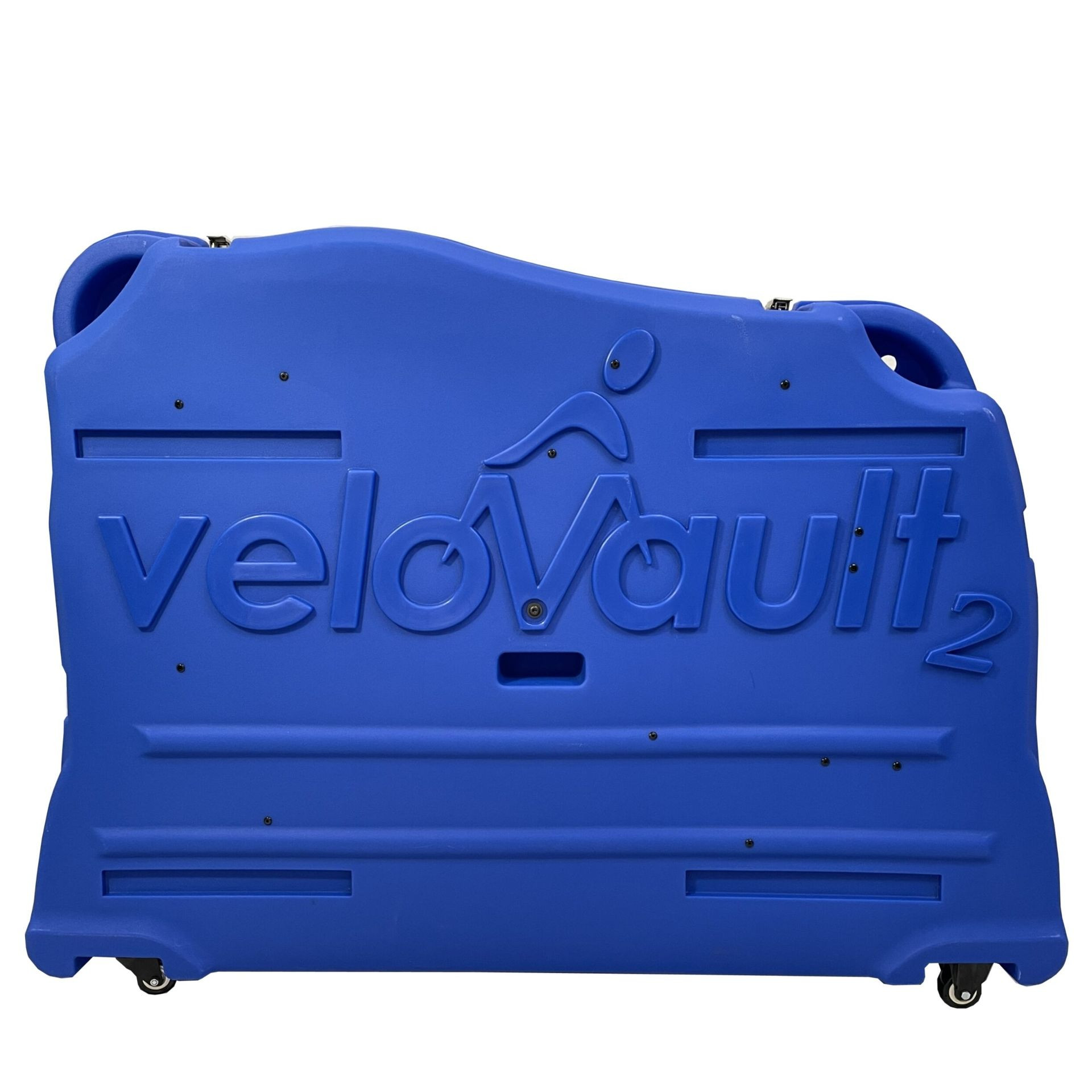 A sturdy blue Velovault2 bike box, perfect for protecting bikes during travel.
A sturdy blue Velovault2 bike box, perfect for protecting bikes during travel.
Alt text: Durable Velovault2 bike box in blue, known for its robustness and quality fixings.
Pros of Hard Bicycle Cases:
- Maximum Protection: Provide the best protection against impacts, crushing, and mishandling.
- Durability: More durable and long-lasting than soft bags, suitable for frequent travelers.
- Security: Offer better security against theft, especially if equipped with locks.
Cons of Hard Bicycle Cases:
- Heavy: Can be heavy and cumbersome, making them difficult to maneuver.
- Expensive: Significantly more expensive than soft bags.
- Storage: Require more storage space due to their rigid structure.
- Less Flexible: May not accommodate bikes of all sizes and shapes.
2.3. Hybrid Options: Striking a Balance Between Soft and Hard Cases
Hybrid bicycle travel bags combine features of both soft bags and hard cases. They typically have a soft exterior with reinforced frames or internal structures for added protection. One example of a hybrid bag is the Scicon Aerocomfort 3.0, blending the flexibility of a soft bag with the protective elements of a hard case.
Advantages of Hybrid Bags:
- Good Protection: Offer a balance between protection and weight.
- Convenience: Easier to handle than hard cases while providing better protection than soft bags.
- Storage: Often designed to be partially collapsible for easier storage.
Disadvantages of Hybrid Bags:
- Price: Can be more expensive than standard soft bags.
- Weight: Slightly heavier than basic soft bags.
Choosing between soft bags, hard cases, and hybrid options depends on your budget, travel frequency, and the level of protection you require for your bike during your Vietnam tours with SIXT.VN.
2.4. Folding Bike Bags: A Special Category for Compact Travel
Folding bike bags cater to travelers with folding bikes, offering compact and convenient transport solutions. These bags are designed to fit the unique dimensions of folded bikes, making them ideal for multimodal travel in Vietnam.
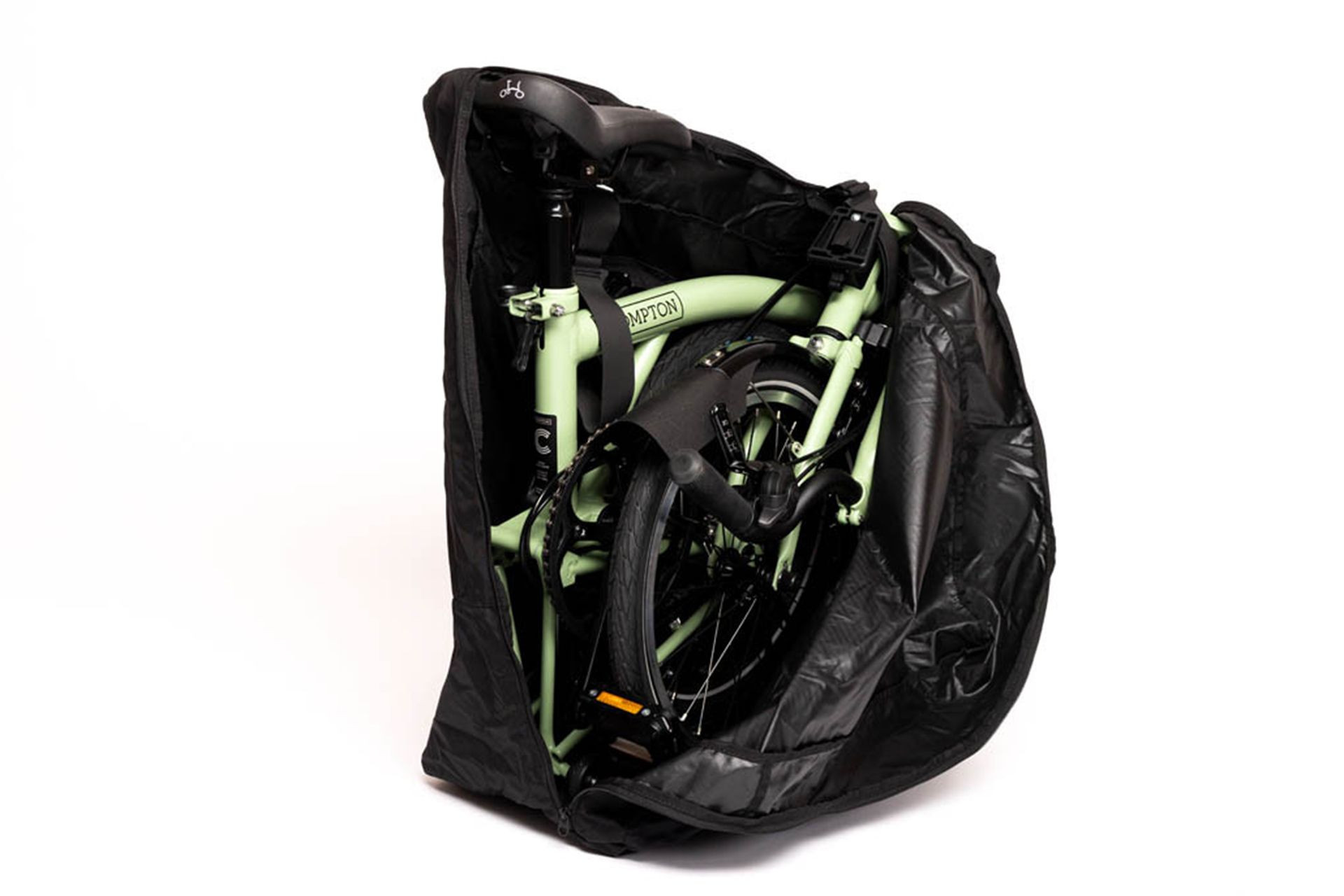 A green Brompton bike folded in a brompton bikes transport bag.
A green Brompton bike folded in a brompton bikes transport bag.
Alt text: Compact Brompton bike in a folding bike transport bag, great for multimodal travel.
Key Features of Folding Bike Bags:
- Compact Design: Specifically designed to fit folded bikes, maximizing space efficiency.
- Lightweight: Made from lightweight materials for easy carrying.
- Portability: Often include shoulder straps or wheels for convenient transport.
- Protection: Padded to protect the bike from scratches and minor impacts.
If you plan to explore Vietnam with a folding bike, investing in a quality folding bike bag will enhance your travel experience. SIXT.VN can assist with the transportation of your folding bike, ensuring a hassle-free journey.
3. What Are The Key Features to Look for in Bicycle Travel Bags?
Selecting the right bicycle travel bag involves considering several key features to ensure it meets your specific needs. These features include size and dimensions, materials and durability, padding and protection, wheels and handles, and additional compartments.
3.1. Understanding Size and Dimensions for Different Bike Types
The size and dimensions of the bicycle travel bag are critical to ensure your bike fits properly. Measure your bike’s frame size, wheelbase, and handlebar width to compare them with the bag’s internal dimensions.
- Road Bikes: Typically require bags with a length of 130-140 cm, a height of 80-90 cm, and a width of 25-30 cm.
- Mountain Bikes: May need larger bags due to wider handlebars and longer wheelbases. Look for bags with dimensions around 140-150 cm in length, 85-95 cm in height, and 30-35 cm in width.
- Folding Bikes: Require compact bags designed specifically for their folded dimensions.
3.2. Evaluating Materials and Durability for Long-Lasting Use
The materials used in a bicycle travel bag determine its durability and ability to withstand the rigors of travel.
| Material | Characteristics |
|---|---|
| Nylon | Lightweight, water-resistant, and abrasion-resistant. Often used in soft bags. |
| Polyester | Strong, durable, and resistant to stretching and shrinking. Another common choice for soft bags. |
| ABS Plastic | Rigid, impact-resistant, and lightweight. Used in hard cases for maximum protection. |
| Aluminum | Strong, lightweight, and corrosion-resistant. Used in high-end hard cases for superior durability. |
| Reinforced PVC | Provides additional strength and water resistance. Often used in high-stress areas of soft bags. |
3.3. Assessing Padding and Internal Protection Mechanisms
Padding and internal protection are essential to prevent damage to your bike during transit. Look for bags with:
- Thick Padding: High-density foam padding around the frame, fork, and other vulnerable components.
- Internal Straps: Secure the frame and prevent movement inside the bag.
- Wheel Compartments: Separate compartments to protect wheels from rubbing against the frame.
- Fork Mounts: Stabilize the fork and prevent it from being crushed.
- Derailleur Guards: Protect the delicate derailleur from impacts.
3.4. Checking for Wheels and Handles for Easy Transportation
Wheels and handles make it easier to transport your bicycle travel bag, especially through busy airports and train stations.
- Wheels: Look for bags with smooth-rolling, durable wheels that can handle various surfaces.
- Telescoping Handle: A retractable handle allows you to pull the bag like a suitcase.
- Carry Handles: Padded carry handles on the top and sides provide comfortable lifting options.
- Shoulder Straps: Some bags include shoulder straps for carrying the bag on your back, though this is less common for larger bags.
3.5. Considering Additional Compartments for Tools and Accessories
Additional compartments can be useful for storing tools, spare parts, and accessories.
- Tool Pockets: Keep your bike tools organized and easily accessible.
- Accessory Pouches: Store small items like pedals, skewers, and repair kits.
- Clothing Compartment: Some bags include a separate compartment for storing cycling clothing and gear.
By considering these key features, you can choose a bicycle travel bag that meets your specific needs and ensures your bike arrives safely for your cycling tours with SIXT.VN.
4. Top Bicycle Travel Bags for Exploring Vietnam with SIXT.VN
When planning a cycling tour in Vietnam, choosing the right bicycle travel bag is crucial. Here are some top-rated options available on the market, highlighting their features, pros, and cons.
4.1. Scicon AeroComfort 3.0 TSA Road Bike Travel Bag: Best Overall
The Scicon AeroComfort 3.0 TSA Road Bike Travel Bag is a favorite among cyclists for its ease of use and excellent protection.
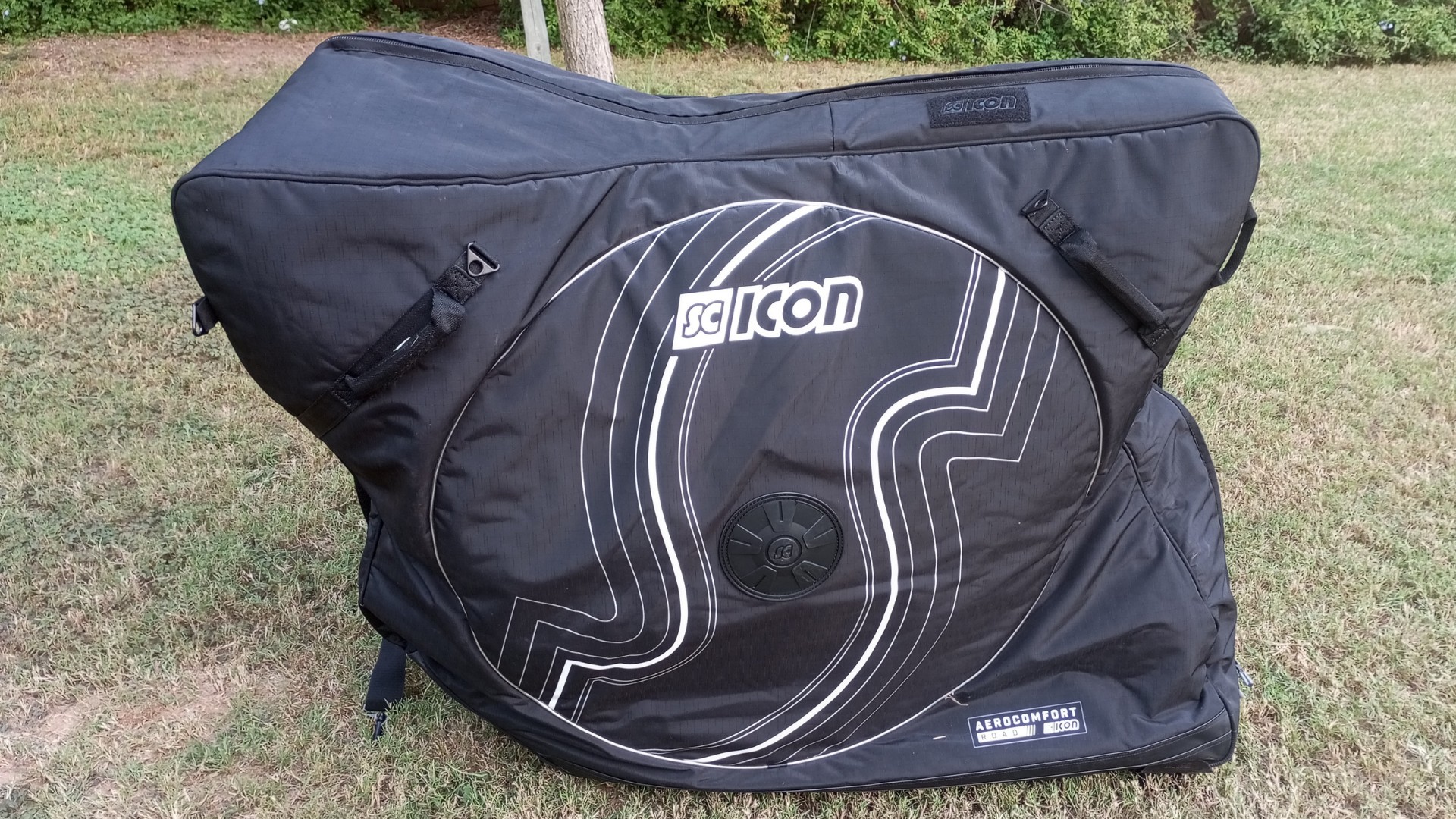 Scicon Aerocomfort 3.0 Bike Bag with a bike packed away inside
Scicon Aerocomfort 3.0 Bike Bag with a bike packed away inside
Alt text: Scicon Aerocomfort 3.0 Bike Bag packed with a bicycle, highlighting ease of use.
Key Features:
- Hybrid Design: Combines a soft exterior with an internal frame for added protection.
- Minimal Disassembly: Requires minimal disassembly of the bike, saving time and effort.
- TSA Lock: Integrated TSA lock for added security.
- Padded Interior: Thick padding protects the frame and components.
Pros:
- Easy to pack and unpack the bike.
- Provides good protection for the frame and components.
- Lightweight compared to hard cases.
Cons:
- More expensive than basic soft bags.
- May not offer the same level of protection as hard cases in extreme conditions.
4.2. Evoc Bike Travel Bag: Best for Ease of Use
The Evoc Bike Travel Bag is known for its user-friendly design and ample storage space.
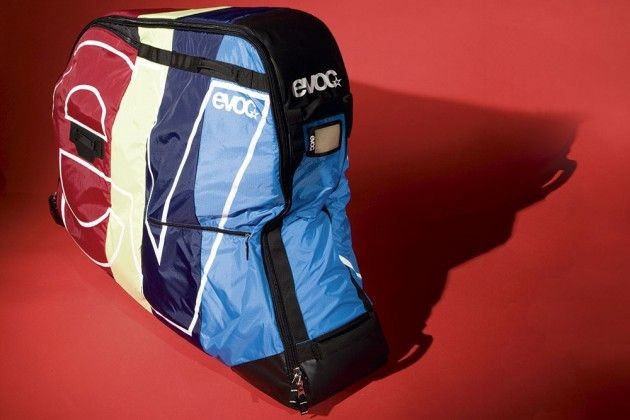 Multi-coloured Evoc bike travel bag
Multi-coloured Evoc bike travel bag
Alt text: Multi-colored Evoc bike travel bag, known for its spaciousness and ease of use.
Key Features:
- Wide Opening: Large side opening makes it easy to load and unload the bike.
- Internal Frame: Provides stability and support.
- Wheel Compartments: Separate compartments for wheels with additional padding.
- Multiple Handles: Convenient carry handles on all sides.
Pros:
- Easy to use and pack the bike quickly.
- Offers good protection with ample padding.
- Spacious interior for storing extra gear.
Cons:
- Soft case design may not offer maximum protection.
- Can be bulky to store when not in use.
4.3. VeloVault2 Bike Box: Most Robust
The VeloVault2 Bike Box is a hard case option designed for maximum protection, making it ideal for those prioritizing safety above all else.
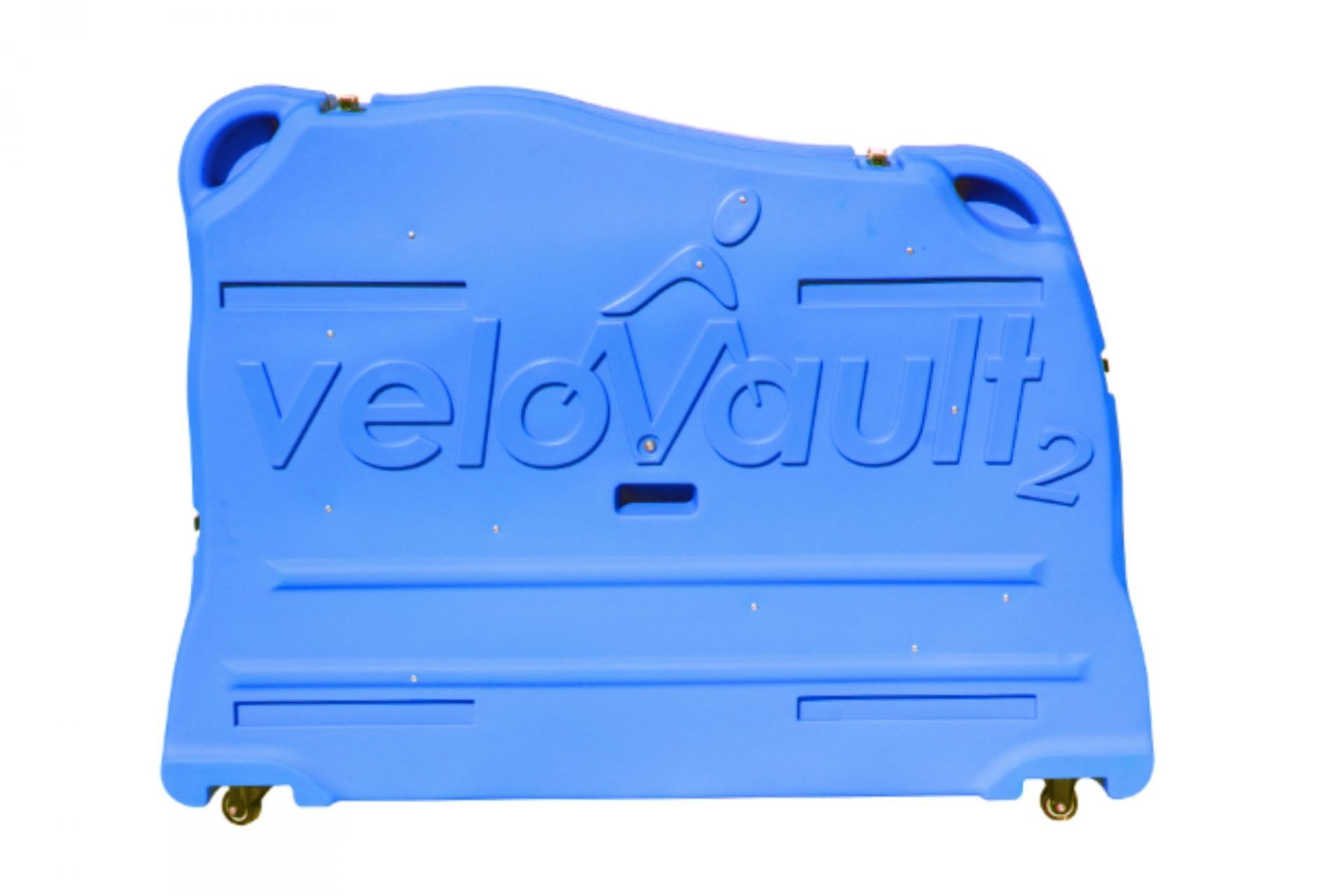 Blue Velovault2 bike box
Blue Velovault2 bike box
Alt text: Blue Velovault2 bike box offering robust protection for bikes during travel.
Key Features:
- Hard Shell: Made from durable ABS plastic for maximum impact resistance.
- Foam Padding: Thick foam padding inside to protect the bike from shocks.
- Secure Latches: Heavy-duty latches ensure the case stays closed during transit.
- Wheels: Integrated wheels for easy rolling.
Pros:
- Provides the highest level of protection for your bike.
- Durable and long-lasting.
- Offers peace of mind for valuable bikes.
Cons:
- Heavy and bulky to transport.
- More expensive than soft bags.
- Requires significant storage space.
4.4. Thule RoundTrip Pro XT Bike Bag: Best with Stand
The Thule RoundTrip Pro XT Bike Bag is a versatile option that doubles as a bike stand, making it convenient for maintenance and assembly during your Vietnam cycling tour.
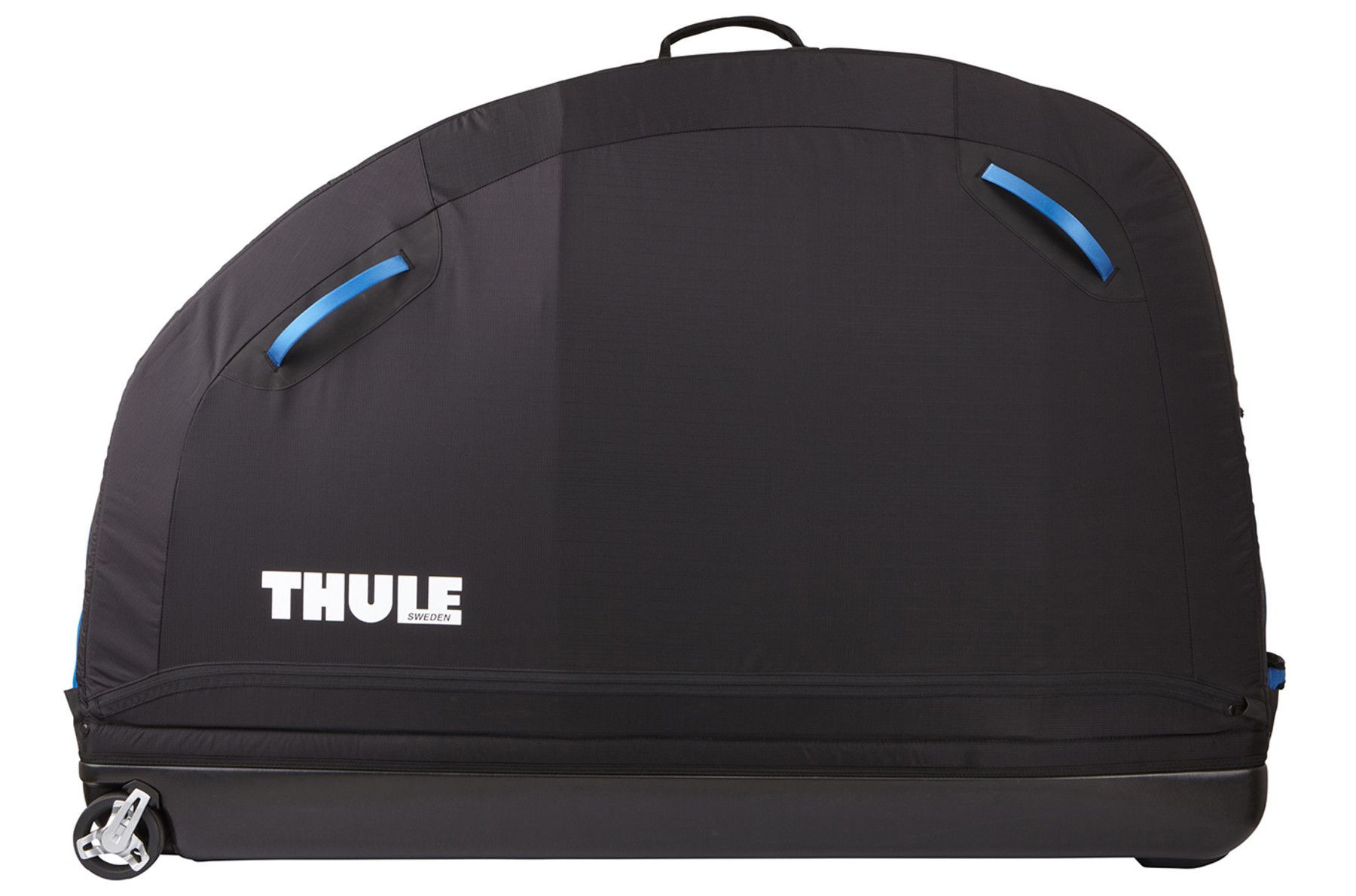 Thule Round Trip Pro XT bike bag
Thule Round Trip Pro XT bike bag
Alt text: Thule Round Trip Pro XT bike bag, known for its versatility and built-in stand feature.
Key Features:
- Integrated Work Stand: Built-in work stand for easy bike assembly and maintenance.
- Hard Shell Base: Provides stability and protection.
- Nylon Fabric: Durable and water-resistant nylon fabric.
- Wheel Bags: Included wheel bags to protect the frame from scratches.
Pros:
- Convenient work stand for on-the-go maintenance.
- Offers a good balance of protection and portability.
- Easy to pack and unpack the bike.
Cons:
- More expensive than other soft bag options.
- The work stand may not be as stable as a dedicated bike stand.
4.5. Orucase B2 Bike Travel Case: Most Portable
The Orucase B2 Bike Travel Case is designed for cyclists who prioritize portability and ease of travel.
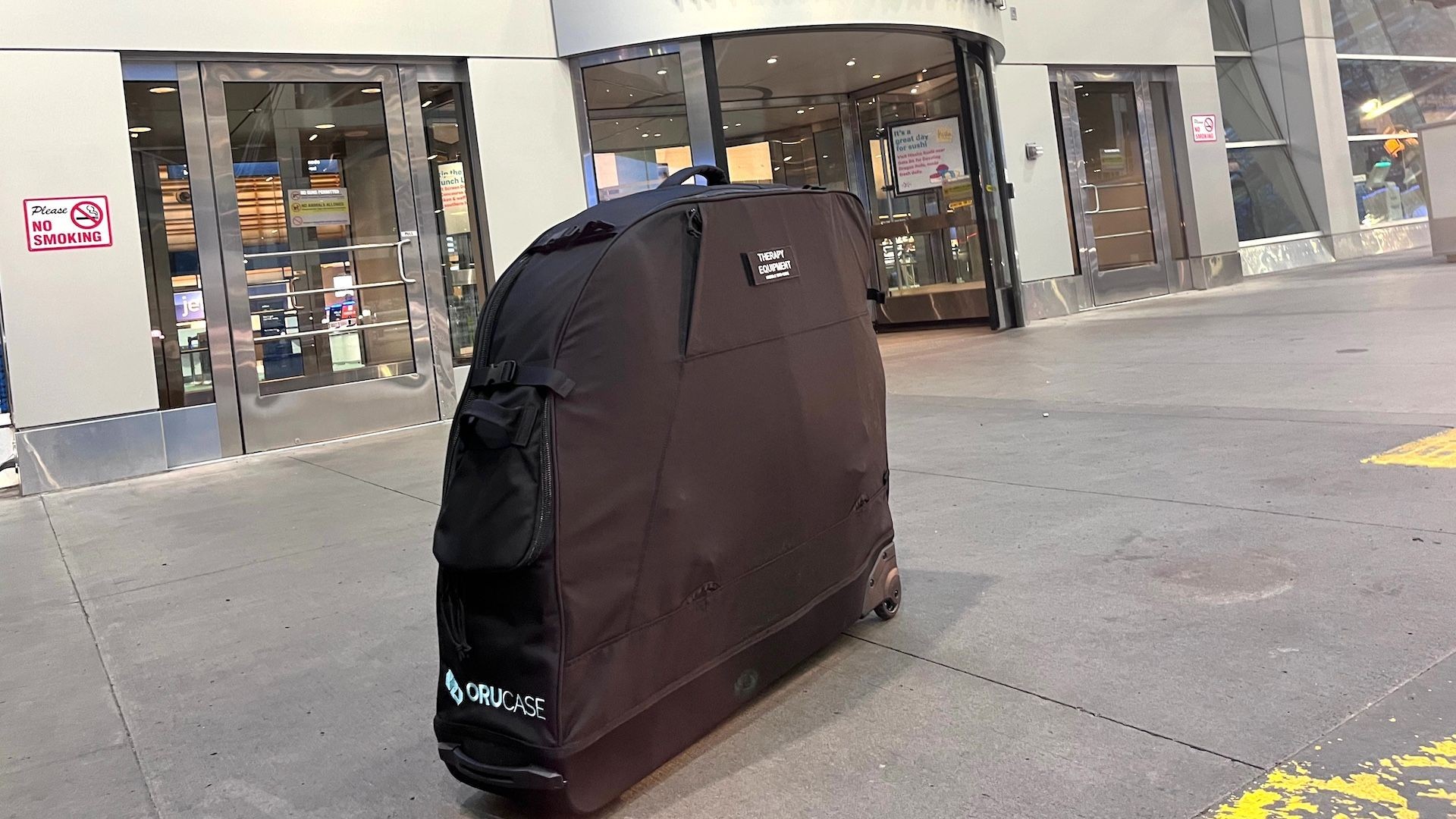 Orucase B2 Bike Travel Case
Orucase B2 Bike Travel Case
Alt text: Orucase B2 Bike Travel Case, highlighting its compact size and high portability.
Key Features:
- Compact Size: Smaller than traditional bike bags, making it easier to maneuver.
- Lightweight: One of the lightest bike travel cases on the market.
- Backpack Straps: Includes backpack straps for easy carrying.
- Minimal Disassembly: Requires some disassembly but is designed for quick packing.
Pros:
- Highly portable and easy to carry.
- Ideal for multimodal travel.
- Saves on extra fees due to its smaller size.
Cons:
- Requires more disassembly than some other options.
- Offers less protection compared to hard cases.
4.6. Scicon Pocket Bike Bag: Best for Trains and Cars
The Scicon Pocket Bike Bag is a basic and lightweight option, perfect for short trips and protecting your car interior when transporting your bike.
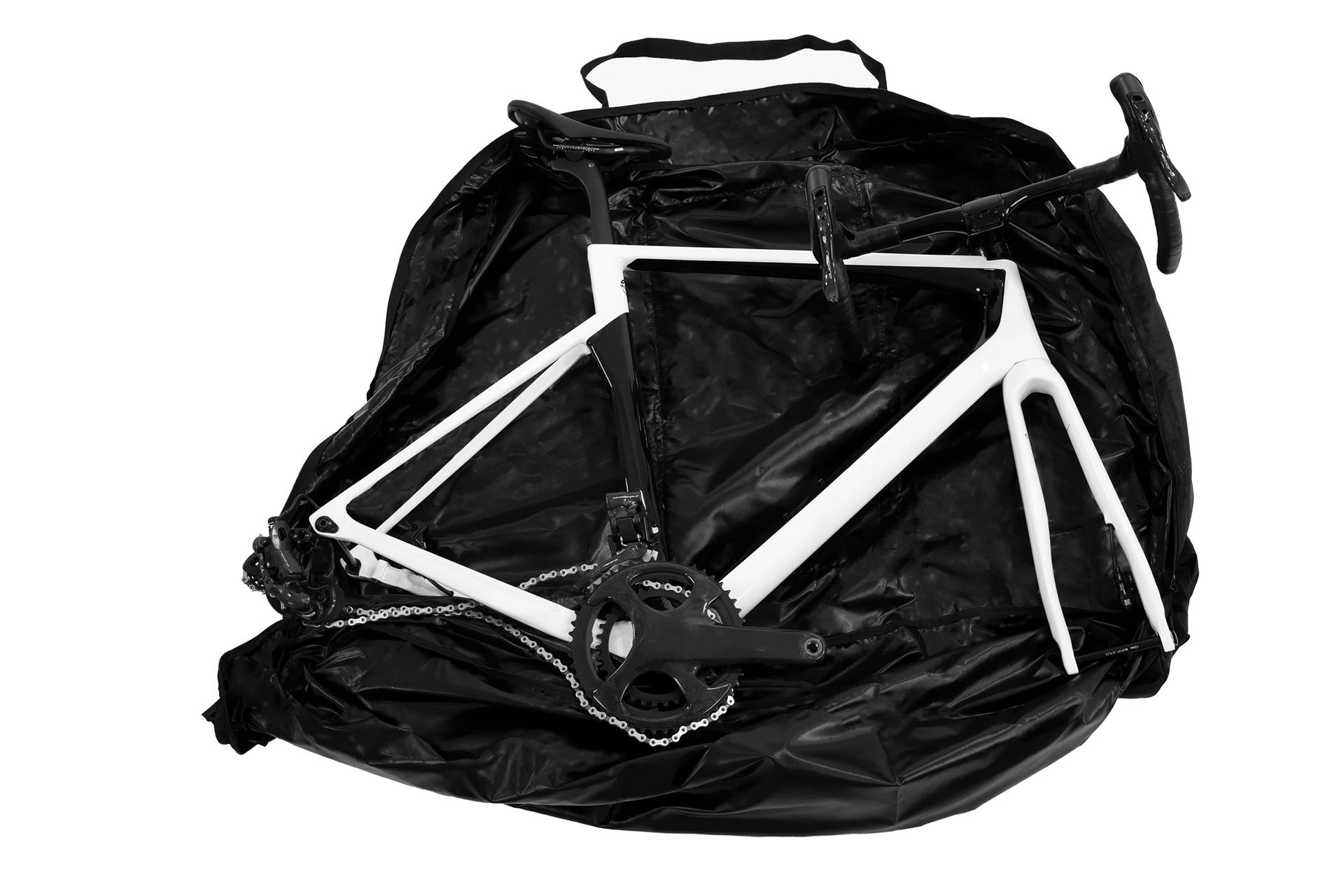 Scicon Pocket Big Bag, a soft very basic bike bag ideal for putting your bike in the car on a train
Scicon Pocket Big Bag, a soft very basic bike bag ideal for putting your bike in the car on a train
Alt text: Scicon Pocket Big Bag, a basic bike bag ideal for car and train transport, keeping interiors clean.
Key Features:
- Lightweight: Weighs only 500g, making it easy to carry and store.
- Compact: Folds into a small package for convenient storage.
- Basic Protection: Provides a barrier against dirt and scratches.
Pros:
- Extremely lightweight and portable.
- Affordable and easy to store.
- Ideal for short trips and protecting car interiors.
Cons:
- Offers minimal protection against impacts.
- Not suitable for air travel or long-distance transport.
These top bicycle travel bags offer a range of features and benefits, ensuring you can find the perfect option for your cycling adventures in Vietnam with SIXT.VN.
5. How to Pack Your Bicycle in a Travel Bag: A Step-by-Step Guide
Packing your bicycle correctly in a travel bag is essential to protect it from damage during transit. Here’s a detailed step-by-step guide to help you pack your bike securely.
5.1. Gathering Necessary Tools and Materials
Before you start, gather the following tools and materials:
- Allen keys
- Wrench
- Pedal wrench
- Bubble wrap
- Foam padding
- Zip ties
- Tape
- Protective sleeves for frame tubes
- Derailleur protector
5.2. Disassembling Your Bicycle for Packing
- Remove Pedals: Use a pedal wrench to remove the pedals. Remember that the left pedal has a reverse thread.
- Deflate Tires: Partially deflate the tires to reduce the risk of them bursting due to pressure changes during air travel.
- Remove Wheels: Remove the wheels from the frame.
- Remove Seatpost: Loosen the seat clamp and remove the seatpost. Mark the insertion point with tape for easy reinstallation.
- Remove Handlebar:
- Option 1: Remove the handlebar from the stem by loosening the faceplate bolts.
- Option 2: Remove the handlebar and stem together from the steerer tube.
- Protect Frame: Cover the frame tubes with bubble wrap or foam padding. Pay special attention to areas that might rub against other components.
- Protect Derailleurs: Install a derailleur protector to prevent damage to the rear derailleur.
5.3. Securing the Frame and Components Inside the Bag
- Place Frame in Bag: Carefully place the frame inside the bicycle travel bag. Use the internal straps to secure it in place.
- Secure Wheels: Place the wheels in the designated wheel compartments or use wheel bags to protect them.
- Attach Handlebar and Seatpost: Secure the handlebar and seatpost to the frame using zip ties or straps. Ensure they are well-padded to prevent damage.
- Pack Small Parts: Place pedals, tools, and other small parts in separate accessory pouches or zip-lock bags. Secure them inside the bag to prevent them from moving around.
5.4. Adding Extra Padding and Protection
- Fill Empty Spaces: Use extra bubble wrap or foam padding to fill any empty spaces inside the bag. This will help prevent the components from shifting during transit.
- Protect Vulnerable Areas: Add extra padding to vulnerable areas like the fork ends, dropouts, and brake levers.
5.5. Final Checks and Closure
- Check for Movement: Shake the bag gently to ensure that nothing is moving around inside. Add more padding if necessary.
- Close the Bag: Close the bag securely, ensuring that all zippers and latches are fastened.
- Inspect the Exterior: Check the exterior of the bag for any signs of stress or potential damage.
By following these steps, you can ensure that your bicycle is well-protected during travel, allowing you to enjoy your cycling adventures in Vietnam with SIXT.VN without worrying about damage to your bike.
6. Tips for Traveling with Bicycle Travel Bags in Vietnam
Traveling with a bicycle in Vietnam can be an exciting adventure. Here are some essential tips to ensure a smooth and hassle-free experience.
6.1. Navigating Airports and Transportation Hubs
- Check Airline Regulations: Before your trip, check the specific regulations for bicycle transport with your airline. Be aware of any size, weight, and packaging requirements.
- Arrive Early: Arrive at the airport or train station early to allow plenty of time for check-in and baggage handling.
- Use Luggage Carts: Utilize luggage carts to transport your bicycle travel bag through the airport or station. This will save you energy and make it easier to maneuver.
- Request Assistance: Don’t hesitate to ask for assistance from airport or train staff if you need help with lifting or transporting your bag.
6.2. Avoiding Extra Fees and Charges
- Weigh Your Bag: Weigh your bicycle travel bag before heading to the airport to ensure it meets the airline’s weight restrictions.
- Pack Strategically: Pack your cycling gear and accessories in your carry-on luggage to reduce the weight of your bicycle bag.
- Pre-Book Baggage: Pre-book your bicycle baggage online to avoid higher fees at the airport.
- Consider Shipping: If possible, consider shipping your bicycle to your destination in advance to avoid airline baggage fees altogether.
6.3. Protecting Your Bag from Damage and Theft
- Use a TSA Lock: Use a TSA-approved lock to secure your bicycle travel bag. This will allow airport security to inspect the bag without damaging the lock.
- Label Your Bag: Clearly label your bag with your name, address, phone number, and email address.
- Take Photos: Take photos of your packed bicycle and the exterior of the bag before your trip. This will help with any insurance claims if your bike is damaged or lost.
- Purchase Travel Insurance: Purchase travel insurance that covers bicycle damage or theft.
6.4. Storing Your Bicycle Bag During Your Trip
- Check Hotel Storage: Check with your hotel or accommodation about bicycle storage facilities.
- Foldable Bags: If you have a soft bag, consider a foldable option that can be easily stored when not in use.
- Arrange Storage: If your hotel doesn’t offer storage, arrange for storage at a local bike shop or storage facility.
6.5. Understanding Local Transportation Options for Cyclists
- Research Routes: Research cycling routes and transportation options in Vietnam. Be aware of traffic conditions and road quality.
- Use Bike-Friendly Transportation: Utilize bike-friendly transportation options such as trains and buses that allow bicycles.
- Hire a Guide: Consider hiring a local cycling guide who can provide valuable insights and assistance.
- SIXT.VN Services: SIXT.VN offers comprehensive travel solutions, including bicycle transport and tour guidance. Contact us to arrange seamless travel for your cycling adventure in Vietnam.
By following these tips, you can ensure a safe, convenient, and enjoyable cycling experience in Vietnam. SIXT.VN is here to assist you with all your travel needs, from bicycle transport to guided tours.
7. Maintaining Your Bicycle Travel Bag for Longevity
Proper maintenance of your bicycle travel bag is essential to ensure its longevity and continued protection for your bike. Here are some tips to keep your bag in top condition.
7.1. Cleaning Your Bag After Each Trip
- Remove Dirt and Debris: After each trip, remove any dirt, dust, or debris from the interior and exterior of the bag.
- Vacuum the Interior: Use a vacuum cleaner with a brush attachment to clean the interior of the bag. Pay special attention to seams and corners where dirt can accumulate.
- Wipe Down the Exterior: Use a damp cloth with mild soap to wipe down the exterior of the bag. Avoid using harsh chemicals or abrasive cleaners.
- Dry Thoroughly: Allow the bag to air dry completely before storing it.
7.2. Storing Your Bag Properly
- Clean Before Storing: Ensure the bag is clean and dry before storing it to prevent mold and mildew growth.
- Store in a Dry Place: Store the bag in a dry, well-ventilated place away from direct sunlight and extreme temperatures.
- Avoid Overcrowding: Avoid overcrowding the storage area, as this can damage the bag.
- Use a Storage Bag: Consider using a storage bag to protect the bicycle travel bag from dust and pests.
7.3. Inspecting for Damage and Making Repairs
- Check for Tears: Regularly inspect the bag for any tears, rips, or holes in the fabric.
- Examine Zippers and Latches: Examine the zippers and latches to ensure they are functioning properly.
- Inspect Wheels and Handles: Inspect the wheels and handles for any signs of wear or damage.
- Make Repairs Promptly: Make repairs promptly to prevent minor damage from becoming more severe. Use a sewing kit to repair small tears or replace damaged zippers and latches.
7.4. Replacing Worn-Out Parts
- Wheels: Replace worn-out wheels with new ones to ensure smooth rolling.
- Handles: Replace damaged or broken handles for comfortable carrying.
- Padding: Replace flattened or damaged padding to maintain protection for your bike.
- Straps: Replace frayed or broken straps to ensure secure fastening.
7.5. When to Consider Replacing Your Bag
- Significant Damage: If the bag has sustained significant damage that cannot be repaired, such as large tears or broken frame components, it may be time to replace it.
- Reduced Protection: If the padding has become flattened or deteriorated, the bag may no longer provide adequate protection for your bike.
- Outdated Design: If the bag is outdated and lacks essential features like TSA locks or improved wheel systems, consider upgrading to a newer model.
- Frequent Repairs: If you find yourself constantly making repairs to the bag, it may be more cost-effective to replace it.
By following these maintenance tips, you can extend the life of your bicycle travel bag and ensure it continues to provide reliable protection for your bike during your cycling adventures in Vietnam with SIXT.VN.
8. Enhancing Your Vietnam Cycling Tour with SIXT.VN Services
Planning a cycling tour in Vietnam involves more than just choosing the right bicycle travel bag. SIXT.VN offers a range of services to enhance your travel experience, from airport transfers to customized tour packages.
8.1. Airport Transfer Services for Cyclists
- Hassle-Free Transportation: SIXT.VN provides airport transfer services specifically designed for cyclists. Our vehicles can accommodate bicycle travel bags, ensuring a hassle-free journey from the airport to your hotel.
- Professional Drivers: Our professional drivers are experienced in handling bicycle travel bags and will ensure your bike arrives safely at your destination.
- Convenient Booking: Book your airport transfer in advance through our website or mobile app.
8.2. Customized Cycling Tour Packages
- Tailored Itineraries: SIXT.VN offers customized cycling tour packages tailored to your interests and fitness level. Whether you prefer exploring the scenic countryside or navigating the bustling city streets, we can create a tour that suits your needs.
- Expert Guides: Our expert guides are knowledgeable about the local culture, history, and cycling routes. They will provide valuable insights and ensure a safe and enjoyable tour.
- Support Vehicles: We provide support vehicles to carry your gear and provide assistance along the way.
8.3. Bicycle Rental Services
- High-Quality Bikes: If you prefer not to bring your own bike, SIXT.VN offers bicycle rental services. We have a range of high-quality bikes available, including road bikes, mountain bikes, and hybrid bikes.
- Well-Maintained Equipment: All our rental bikes are well-maintained and equipped with essential accessories.
- Flexible Rental Options: We offer flexible rental options to suit your needs, whether you need a bike for a day, a week, or longer.
8.4. Accommodation Booking Assistance
- Wide Range of Options: SIXT.VN can assist you with booking accommodation that is suitable for cyclists. We have a wide range of options available, from budget-friendly guesthouses to luxury hotels.
- Bike-Friendly Hotels: We can recommend hotels that offer secure bicycle storage facilities and are located near popular cycling routes.
- Convenient Booking: Book your accommodation through our website or mobile app for a seamless travel experience.
8.5. Travel Insurance Options
- Comprehensive Coverage: SIXT.VN offers travel insurance options that provide comprehensive coverage for your cycling tour.
- Bicycle Coverage: Our travel insurance covers bicycle damage, theft, and loss, ensuring you are protected in case of unforeseen events.
- Peace of Mind: Travel with peace of mind knowing you have adequate insurance coverage for your cycling adventure.
By utilizing SIXT.VN’s comprehensive services, you can ensure a smooth, enjoyable, and unforgettable cycling tour in Vietnam. Contact us today to start planning your dream cycling adventure.
Address: 260 Cau Giay, Hanoi, Vietnam
Hotline/Whatsapp: +84 986 244 358
Website: SIXT.VN
9. FAQ About Bicycle Travel Bags
9.1. Can I Leave My Di2 or AXS Batteries on My Bike When Traveling?
If you are travelling by land or sea, we see no harm in this. However, if you are travelling by air, it’s worth checking with the airline, but their general guidance would be to remove them and put them in your carry-on. At the very least, you know you will have them when you reach your destination.
9.2. Will I Have to Pay Extra for a Bike Bag or Box?
This very much depends on the service provider and how they account for bike bags and boxes. For most airlines now, there will almost certainly be additional charges, and you will need to have sorted that before you reach the airport. For some EU train services, you will have to book ahead and won’t be able to travel if you haven’t, as spaces are limited. However, these generally incur much smaller charges.
9.3. Will My Travel Insurance Cover My Bike If It’s Damaged?
Generally, yes, as most cover all luggage; however, the value is down to individual policy, and not all will cover excess baggage. We recommend looking at the best bicycle insurance, as these are much better tailored to dealing with these scenarios and will handle any claims made more effectively.
9.4. What size bicycle travel bag do I need?
Measure your bike’s frame size, wheelbase, and handlebar width to ensure they fit within the bag’s internal dimensions.
9.5. Is a hard case or soft bag better for my bike?
Hard cases offer maximum protection, while soft bags are lighter and easier to store. Choose based on your priority for protection versus convenience.
9.6. Can I carry cycling tools in my bike travel bag?
Yes, but pack them securely in separate compartments or pouches to prevent damage to your bike.
9.7. How much does it cost to transport a bicycle on a plane?
Costs vary by airline, so check with your specific carrier for their bicycle transport fees and regulations.
9.8. Do I need to deflate my tires when transporting my bike?
Partially deflating your tires is recommended to prevent bursting due to pressure changes during air travel.
9.9. How can SIXT.VN help with my cycling tour in Vietnam?
SIXT.VN provides airport transfers, customized tour packages, bicycle rentals, accommodation booking assistance, and travel insurance options to enhance your cycling experience.
9.10. Is it safe to travel with a bicycle in Vietnam?
Yes, with proper planning, a good bicycle travel bag, and reliable transportation services like those offered by SIXT.VN, you can have a safe and enjoyable cycling tour in Vietnam.
10. Conclusion: Choose The Right Bicycle Travel Bag for Your Vietnam Adventure with SIXT.VN
Choosing the right bicycle travel bag is a crucial step in planning your cycling adventure in Vietnam. Whether you opt for a soft bag, hard case, or hybrid option, ensuring your bike is well-protected during transit is essential for a smooth and enjoyable trip. SIXT.VN offers a range of services to enhance your cycling tour, from airport transfers to customized tour packages, making your travel experience hassle-free and unforgettable.
Remember to consider key features such as size, durability, padding, and ease of transportation when selecting your bicycle travel bag. Proper packing and maintenance will further safeguard your bike and extend the life of your bag. With SIXT.VN’s comprehensive travel solutions, you can explore the scenic landscapes and vibrant culture of Vietnam with confidence, knowing that your cycling needs are well taken care of.
Start planning your dream cycling tour in Vietnam today with SIXT.VN. Contact us to arrange seamless travel, expert guidance, and unforgettable experiences.
Address: 260 Cau Giay, Hanoi, Vietnam
Hotline/Whatsapp: +84 986 244 358
Website: SIXT.VN



